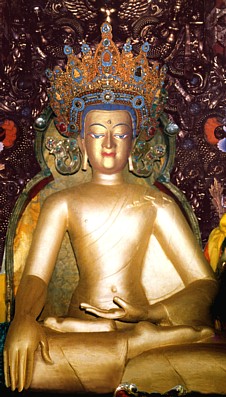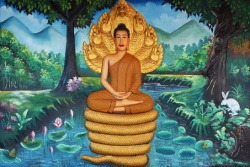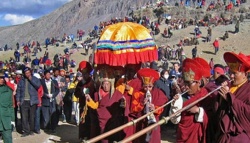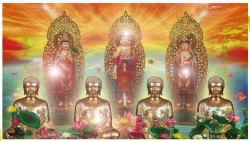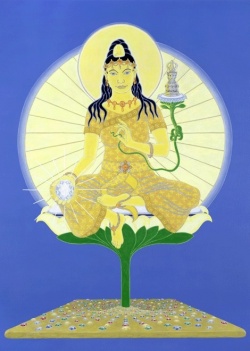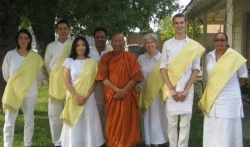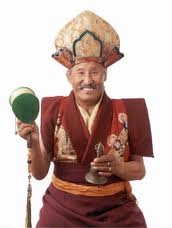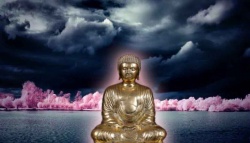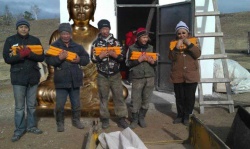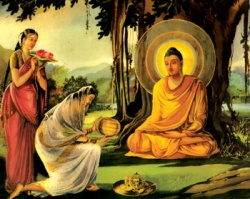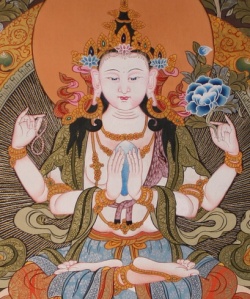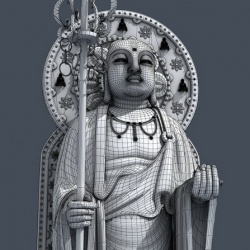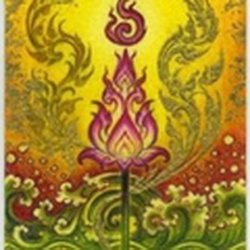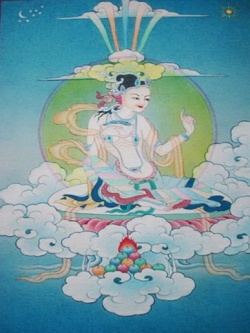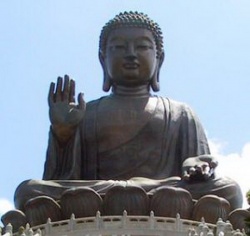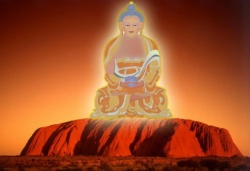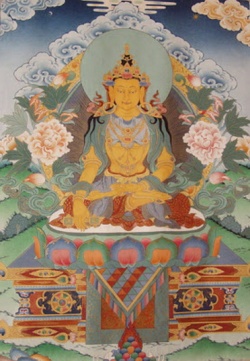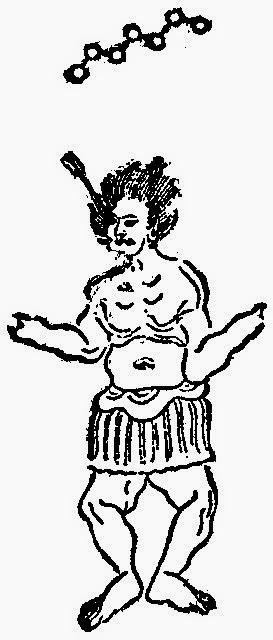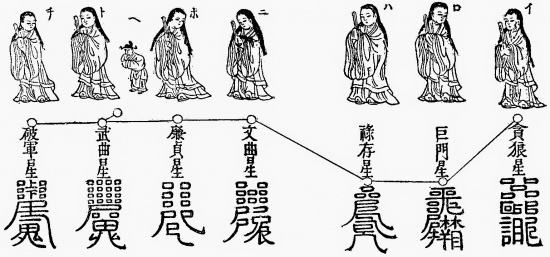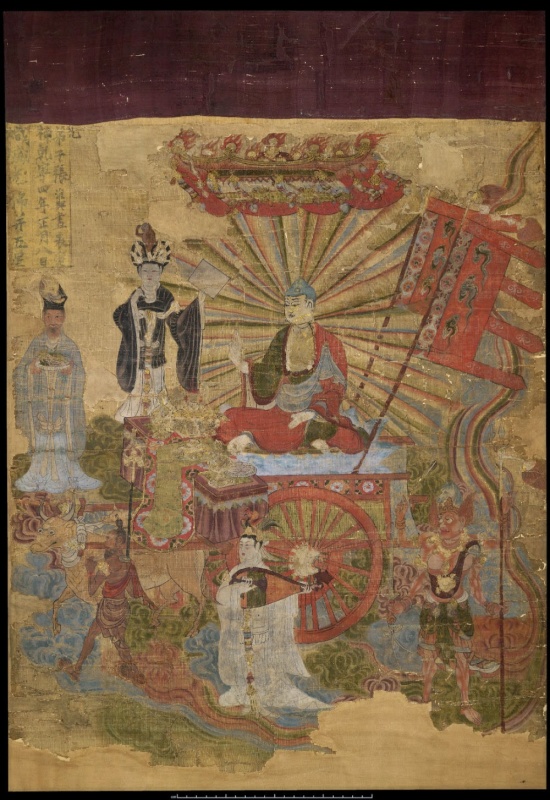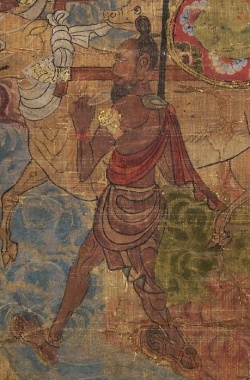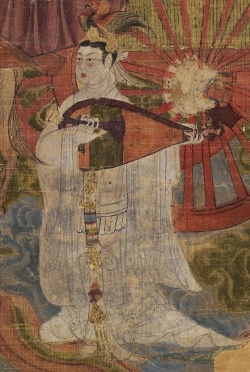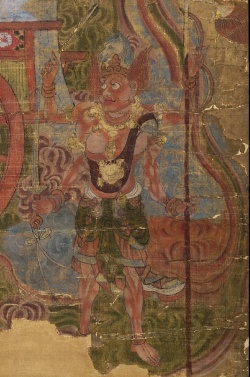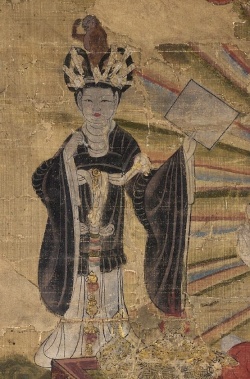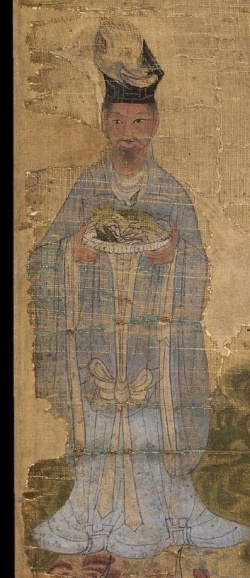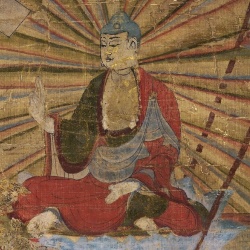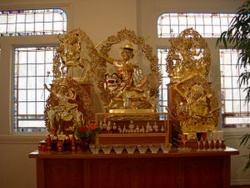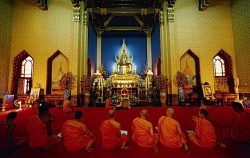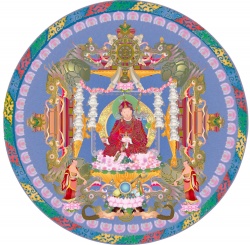The Reality of Astrology in East Asia
It might surprise the modern reader of East Asian Buddhist history – be it with respect to Zen or any other tradition in the Sinosphere – that astrology has played a significant role from early on. Some time ago I came across the twelve zodiac houses in a Buddhist sūtra in Chinese translation which immediately sparked my interest.[1] I had not read nor heard of such things before in the Chinese Buddhist canon. It seemed reasonable that Chinese astrology might have been practiced amongst Buddhist clerics in ancient times, though why were the twelve zodiac houses appearing in a Buddhist scripture in Chinese translation?
I had read some work on Vedic astronomy – specifically the work of Richard L. Thompson: Vedic Cosmography and Astronomy[2] – and was aware that Babylonian-Hellenic influences were present in Brahmanical traditions in India, though was unaware how early those influences carried over into Buddhist literature. To my surprise those influences were evidently transferred over into Chinese translations.
Later well-developed and widely practiced models of Buddhist astrology emerged which effectively combined early albeit probably unrecognizable Babylonian elements together with multiple levels of Indian developments, thereafter merging with mainstream Buddhist traditions and finally in China being coupled with Daoist ideas. Even beyond that point at least one major system was imported into Japan and further developed – the Sukuyō-dō 宿曜道, based on the Xiuyao-jing 宿曜經 (in Japanese Sukuyō-kyō) purportedly translated by Amoghavajra in 759 and later revised in 764 by disciple Yang Jingfeng 楊景風 under his master's guidance – which became popular for a few centuries with famous literature like the Tale of Genji making reference to it. Likewise astrology had a role to play in medieval Korean history.
From a scholarly point of view this is all quite fascinating albeit extremely complex. To really understand the subject at hand requires a pan-Eurasian perspective spanning thousands of years plus knowledge of science and religion in both the Indosphere and Sinosphere. This perhaps explains why the subject of Buddhist astrology has not received so much attention at the academic level. As noted above, after several years of researching East Asian Buddhism I had seldom ever saw mention of astrology. At the popular level in the western world many people are aware of the living tradition of Tibetan astrology, though it is less known that Sukuyō-dō in Japan is likewise alive and still practiced (there are plenty of recently published manuals for sale online).
In this discussion I want to describe the significance of astrology in East Asian Buddhism, which is somewhat unappreciated and largely unrecognized in all but specialized scholarly works, even in the Chinese and Japanese speaking worlds. This is not a popular subject perhaps owing to the widespread interest supposedly more rational or practical traditions of Buddhism on the part of both contemporary scholars and modern Buddhist writers, both east and west. Nevertheless, I want to stress that historically astrology was a part of Buddhist society in China and later in Korea and Japan, and that arguably it had an influential role both in contributing to traditions of mysticism, but also building bridges between Buddhist society and more strictly non-Buddhist elements of society.
One problem perhaps with the term “Buddhist astrology” is that, strictly speaking, plenty of Buddhist scriptures forbid astrology and divination, yet nevertheless there were astrological texts with clearly Buddhist themes emerging in India and later being translated in China. In the latter the prevailing models of the Vinaya and Mahāyāna bodhisattva precepts plus widely available popular scriptures are quite clear that monks at least are not supposed to practice such things, even though they did.
For example, such a proscription is found in the Sūtra of the Buddha's Bequeathed Teachings 佛遺教經, which is a summary of the Buddha's teachings provided shortly before his death among the śāla trees in Kushinagar. The translation is credited to Kumārajīva (344-413) and later was widely read, especially in the Chan school even up until present times. There is no extant Indian original (and there might never have been), though Paramārtha (499-569) in the sixth century translated a commentary on the sūtra ascribed to Vasubandhu. In addition, there are many more classical commentaries on the text by authors in East Asia. The sūtra is short and easy to read, which helps explain its popularity over the centuries.
One interesting feature of the text is that it expressly forbids a practitioner from certain occult activities which were ubiquitous and often part of the Buddhist priestcraft trade in China. The relevant part of the sūtra reads as follows:
- 《佛垂般涅槃略說教誡經》卷1:「持淨戒者,不得販賣貿易、安置田宅、畜養人民奴婢畜生,一切種殖及諸財寶,皆當遠離如避火坑。不得斬伐草木、墾土掘地,合和湯藥、占相吉凶、仰觀星宿推步盈虛曆數算計,皆所不應。節身時食清淨自活,不得參預世事通致使命,呪術仙藥、結好貴人親厚媟嫚,皆不應作。當自端心正念求度,不得苞藏瑕疵、顯異惑眾。於四供養知量知足,趣得供事不應稸積,此則略說持戒之相。」
- He who maintains the pure precepts may not engage in commerce and trade, the establishment of fields and estate, nor may he keep ordinary people, slaves and livestock. They should all remain far from all manner of planting and wealth as they would avoid a pit of fire. They may not cut grass and trees, till the soil, dig in the ground, mix medicines, divine fortunes, study the stars, foretell the future by observing changes in natural phenomena, nor gauge auspicious days on the calendar. All such activities are improper. They maintain themselves eating at the appropriate time and live a pure life. They are not to be involved in mundane affairs: being an envoy, casting spells, practicing alchemy, intimately associating with high people or immodestly jesting with one's intimates. These are all improper. They should seek liberation with a straight mind and mindfulness. They may not conceal their flaws nor reveal strange things to delude the masses for personal gain. They know limits and know what is sufficient with the four kinds of offerings. Having gone to receive an offering they must not hoard it. This is a general explanation of the qualities of maintaining the precepts.[3]
The text basically prescribes a bhikṣu lifestyle in accordance with the traditional Vinaya. As we discussed in earlier articles on this blog (see here and here), the Vinaya in both India and China was only ever partially implemented, and even less so in the latter (to say nothing of Japan which eventually abandoned the Vinaya altogether). With respect to the implementation of the Vinaya in India, Gregory Schopen has stated, “There appears to be, however, no actual evidence that the textual ideal was ever fully or even partially implemented in actual practice; at least none is ever cited.”[4]
It is therefore unsurprising that Chinese and later East Asian monks from elsewhere did not ever seriously attempt to implement or follow even the basic rules of the Indian Vinaya. While it is easy to recollect the absence of fasting past noon and daily rounds of begging for food in East Asian Buddhist history, we should also be aware that their Vinaya literature generally prohibits bhikṣus and bhikṣuṇīs from engaging in divination and astrology, even though these practices are clearly provided in some sūtras, some of which predate the translation of Vinaya texts in China.
For instance, the Mātaṅga Sūtra 摩登伽經, translated into Chinese in 230 CE by Zhiqian 支謙, is the oldest known Indic sūtra translated into Chinese to include jyotiṣa (Indian astrology) elements such as the 28 nakṣatra-s, 9 graha-s, monthly gnomic and the Metonic cycle. This was long before the first major Vinaya prātimokṣa the Sarvāstivāda Vinaya 十誦律 was translated in 406.
The Dharmagupta Vinaya 四分律 (translated in 413) – the prātimokṣa and Vinaya model most commonly used in China after it was made official between 705-710 under the influence of Vinaya master Dao'an 道岸 (654-717)[5] – specifically proscribes the practice of divination:
- 《四分律》卷52:「時六群比丘與女人卜占。佛言不應爾。復從人卜占。佛言不應爾。」
- At one time the group of six bhikṣus did divination with a lady. The Buddha said it should not be so. Again they did divination with a man. The Buddha said it should not be so.[6]
The text also specifically forbids sangha members from forecasting astrologically auspicious dates for various mundane activities (i.e., electional astrology), but instead commands that they advocate Buddhist practice:
- 《四分律》卷30:「又不得言今日有如是星宿好。宜起舍宜種作宜使作人宜為小兒剃髮長髮剃鬚。應語言。宜入塔寺供養比丘僧受齋法。八日十四日十五日現變化日。彼比丘尼。以如是世俗技術教授白衣乃至宜出遠行。說而了了者波逸提。不了了者突吉羅。比丘突吉羅。式叉摩那沙彌沙彌尼突吉羅。是謂為犯。不犯者。教言。莫向如來塔及聲聞塔大小便及除糞掃不淨水。亦莫向如來塔及聲聞塔舒脚。若耕田種作若起房舍。向如來塔乃至受齋法。若戲笑語。若疾疾語。若獨語夢中語。欲說此乃錯說彼無犯。無犯者。最初未制戒。癡狂心亂痛惱所纏」
- It also must not be said, “Today there are good constellations like this. It is appropriate to erect a building, to farm, hire people, shave off the hair of a child, grow one's hair or shave one's beard.” It should be said, “It is appropriate to enter the temples to make offerings to the bhikṣu sangha and receive teachings on the fast on the eighth, fourteenth, fifteenth, and days when [the Buddha) manifest supermundane abilities.” Those bhikṣuṇīs teach the laypeople with worldly arts like this and [tell people) it is appropriate to travel a distance [because it is an auspicious day). To fully teach [like this] constitutes a pāyattika offense. If not fully [[[taught]]), it is a duṣkṛta offense. For a bhikṣu it is a duṣkṛta. For a śikṣamāṇā, śrāmaṇera and śrāmaṇerī it is a duṣkṛta. These constitute transgression. As for non-transgression, it is if teaching and saying, “Do not defecate, urinate or dispose of garbage and unclean water while facing stūpas of the Tathāgata and śrāvaka-s. Also do not unfold one's legs while facing stūpas of the Tathāgata and śrāvaka-s. If farming or erecting a building, face the stūpa of the Tathāgata and/or receive the teachings on the fast.” There is no transgression if [the earlier forbidden items] are stated in jest, hastily, alone to oneself, in a dream or wanting to say it but making mistakes in speech. There is no transgression if it was when the precept had first not yet been established, or one is insane with mind perturbed or bound by illness.[7]
The eighth, fourteenth, fifteenth were astrologically significant from early on in Buddhism. In other texts devas descend to inspect people's virtues on the 8th, 14th, 15th, 23rd, 29th and 30th (the month is broken into two fifteen day parts according to the waning and waxing of the moon, which can also be taken together as a single thirty day month or fifteen days each). For instance, the Abhidharma Mahāvibhāṣā Śāstra 阿毘達磨大毘婆沙論 states the following:
- 《阿毘達磨大毘婆沙論》卷41:「問何故唯說三十三天。答以彼諸天數數雲集論善惡事故偏說之。謂彼諸天於白黑月。每常八日若十四日若十五日。集善法堂稱量世間善惡多少。復次三十三天常共伺察造善惡者。見造善者便擁護之。見造惡者即共嫌毀。」
- Question – Why only speak of thirty-three devas? Answer – The devas frequently gather to discuss good deeds and misdeeds. Hence the partial discussion of them. The devas during the waxing and waning moons on every eighth, fourteenth and fifteenth always gather in the Hall of Saddharma to weigh the amount of good deeds and misdeeds in the world. Furthermore, the thirty-three devas constantly together inspect the creators of good deeds and misdeeds. Seeing one who has created good deeds, they then protect them. Seeing one who has created misdeeds, they then together resent and ruin them.[8]
The Abhidharma Mahāvibhāṣā Śāstra, attributed to Kātyāyanīputra, is generally held to have been composed sometime around the 2nd century CE in northwest India. It is a key treatise of the Kashmir Sarvāstivāda school. Another Sarvāstivāda text also describes the significance of the aforementioned days. The significance of these specified days on the lunar calendar was probably shared with other native traditions at the time in Magadha. See the Sarvāstivādanikāya Vinaya Mātṛkā:
- 《薩婆多部毘尼摩得勒伽》卷6:「王舍城諸外道八日十四日十五日。集一處唄誦多得利養。眷屬增長。爾時瓶沙王信佛法僧。往詣佛所。... 佛言。聽諸比丘八日十四日十五日集一處唄誦說法。」
- The heterodox of Rājagṛha on the eighth, fourteen and fifteenth would gather in one place to chant, gaining many offerings with their retinues growing. At that time King Bimbisāra had faith in the Buddha, Dharma and Sangha. He went to visit the Buddha. ... The Buddha said, “I permit bhikṣus to gather in one place to chant and teach the Dharma on the eighth, fourteenth, and fifteenth.”[9]
One last example is the Four Deva Kings Sūtra 四天王經 (*Catur Devarāja Sūtra) – which is also quoted in Nāgārjuna's (c. 2nd-3rd cent.) Mahāprajñāpāramitā Upadeśa – detailing how the Four Mahārāja under Indra's direction descend with their entourages to inspect the world and its inhabitants. See the following:
- 《佛說四天王經》卷1:「諸天齋日伺人善惡。須彌山上即第二忉利天,天帝名因,福德巍巍,典主四天。四天神王即因四鎮王也,各理一方,常以月八日遣使者下,案行天下,伺察帝王、臣民、龍鬼、蜎蜚、蚑行、蠕動之類,心念、口言、身行善惡;十四日遣太子下;十五日四天王自下;二十三日使者復下;二十九日太子復下;三十日四王復自下」
- The devas on the fasting days examine the good deeds and misdeeds of people. Atop Mount Sumeru there is the second [[[desire realm]] heaven) of Trāyastriṃśa where there is the celestial sovereign named Indra whose virtues are lofty. The chief four devas, the four deva kings, are Indra's four guardian kings, each managing one direction. On the eighth day of the month envoys are always dispatched who descend on an inspection tour of the whole world. They investigate the sovereigns, kings, officials, citizens, nāgas, spirits, fliers, crawlers and wrigglers – the good deeds and misdeeds in the thoughts of their minds, the speech of their mouths and the actions of their bodies. On the fourteenth day he dispatches the princes who descend. On the fifteenth day the four kings themselves descend. On twenty-third day the envoys again descend. On the twenty-ninth the princes again descend. On the thirtieth day the four kings again personally descend.[10]
It is clear then that auspicious and inauspicious days were a concern of Buddhists early on and even canonical non-Mahāyāna texts reveal this. This was likewise true outside the Indosphere in a country like China which had equally longstanding interests in astrology.
As noted above, conventional sūtras like the Sūtra of the Buddha's Bequeathed Teachings likewise expressly forbid practicing astrology or divination without even the proviso that one may do so if it is to support the Buddhist cause to some effect as noted above in the Dharmagupta Vinaya. Similar proscriptions are found also in the Brahma Net Sūtra 梵網經 (translation also credited to Kumārajīva in the early fifth century, though scholars largely believe the text was composed in China), which is significant given the popularity of the text and how it provides what became the standard set of bodhisattva precepts in East Asian Buddhism. Note the following:
- 《梵網經》卷2:「若佛子。以惡心故為利養故。販賣男女色。自手作食自磨自舂。占相男女。解夢吉凶。是男是女。呪術工巧調鷹方法。和合百種毒藥千種毒藥蛇毒生金銀蠱毒。都無慈心。若故作者。犯輕垢罪。」
- If intentionally done it constitutes a minor transgression should a disciple of the Buddha with unwholesome intent and for personal gain of wealth buy and sell men and women for prostitution, or with their own hand cook, mill and grind, or do divination for men and women, or interpret the auspiciousness or inauspiciousness of dreams predicting the gender of children, or practice magic, or engage in labor [for money), or train falcons, or mix all manner of poisons from snakes, gold, silver and insects. All [such acts] lack compassion.[11]
Here the meaning of “divination for men and women” would seem to include astrology. In a commentary on this sūtra by Huayan patriarch Fazang 法藏 (643-712) he suggests this means divining when it is appropriate for a man and woman to get married or reading moles on the body.[12] The term in Chinese zhan xiang 占相 is defined in the modern Hanyu Da Cidian 漢語大詞典 as “surveying some certain natural phenomena or a person's face or complexion to predict auspiciousness or fortune.”[13] In the context of this sūtra this would presumably include surveying the stars, which was a practice common both in India and China.
Again it can be noted here there is an unspoken proviso that such practices are improper only if done with unwholesome intent or for personal gain. The erudite Vinaya master Daoxuan 道宣 (596-667) also includes astrology as a wrong livelihood, though with Daoxuan this does not preclude the possibility of practicing it for religious motivations.
- 《四分律刪繁補闕行事鈔》卷1:「破正命者。謂非法乞求邪意活命。則有五種四種。言五邪者。一謂為求利養改常威儀詐現異相。二謂說己功德。三者高聲現威。四者說己所得利養激動令施。五者為求利故強占他吉凶。言四邪者。一方邪者。通使四方為求衣食。二仰邪者。謂上觀星象盈虛之相。三者下邪。即耕田種殖種種下業。四者四維口食。習小小呪術以邀利活命。此智論解也。」
- Destroying right livelihood is inappropriate solicitation or by wicked intent supporting oneself, of which there are five and four types. The five types:
- The four types:
- I. Wickedness at a distance: dispatching envoys to the four directions in pursuit of clothing and food.
- II. Wickedness by looking upwards: surveying above features of star signs and lunar cycles.
- III. Wickedness below: tilling fields, planting seeds and various acts directed downwards.
- IV. The four ways to eat by way of the mouth: learning small spells to invite profit to support oneself.
- This is the understanding of the Mahāprājñāpāramitā Upadeśa.[14]
As Daoxuan notes, his points here are derived from Nāgārjuna's Mahāprājñāpāramitā Upadeśa 大智度論, translated by Kumārajīva between 402-406. Again it is noteworthy that the aforementioned Sūtra of the Buddha's Bequeathed Teachings was translated around the same time, which means from the early fifth century onward China had a widely read sūtra, śāstra (or upadeśa) and fully translated Vinaya codes that prohibited astrology, at least for personal gain. The tone of these works though suggest to me that the expectation is that a bhikṣu will not engage in such practices altogether, yet it might be begrudgingly accepted if it is done for religious reasons.
The extant Vinaya literature from India of all schools displays an ongoing constant fear of spoiling the sangha image for laypeople, yet at the same time it occasionally does compromise to provide desirable services to laypeople. As cited above the Dharmagupta Vinaya commands that the sangha must not advise people to engage in worldly acts when it is astrologically auspicious, yet it is permissible to advise the masses to do religious acts when appropriate on auspicious days (such as on the 8th, 14th and 15th in a fifteen day lunar phase when powerful devas descend into the world). This sort of approach carried over to China as well, though concern for the Vinaya altogether was seldom significant.
The translation and implementation of Buddhist astrology texts, at least at the upper levels of the clergy, would suggest that generally speaking astrology was never significantly opposed from the introduction of Buddhism and then throughout the Tang Dynasty. This is unsurprising given the role astrology/astronomy played in China from ages long before the introduction of Buddhism. Imperial courts kept logs of notable astronomical events, which were included in the official dynastic histories. Court astrologers were also important and well-paid members at court.
For example, during the Eastern Han Dynasty (25-220) a bureau of astronomy was established. High ranking officials had the task of observing the sky, having direct access to the emperor and advising him according to their own observations. The Later Book of Han 後漢書, a history of the Eastern Han, details the tasks of the office of tai-shiling 太史令 (court astronomer), an upper-middle appointment, as follows:
- 掌天時、星曆。凡歲將終,奏新年曆。凡國祭祀、喪、娶之事,掌奏良日及時節禁忌。凡國有瑞應、災異,掌記之。
- He is charge of [monitoring] the Mandate of Heaven and the calendar. He reports on the new year's calendar whenever the year is about to conclude. He is in charge of reporting good days and taboo times whenever there are national sacrifices, funerals or weddings. He is in charge of recording auspicious responses, calamities and abnormalities whenever the country has them.
His monthly salary came to 3500 cash in 106 CE. To put that into perspective, the accessory clerks made 400 cash per month while the highest member on the salary list was paid 17,500 cash, the next best with 9000.[15] Thus while the court astronomer was not the top paid member of the bureaucracy, clearly his services were important enough to merit a comfortable income.
To be an astrologer was a respectable profession. While some Buddhist texts from India might have regarded it as worldly and inappropriate for Buddhist disciples, in China such a taboo did not seem to exist or ever really be significantly adopted from Indian Buddhist texts, which helps to explain the success of esoteric astrology texts from the late seventh century onwards.
A few decades after Daoxuan's passing the monk Yixing 一行 (683-727) rose to prominence as an esoteric monk who was adept in astrology and calendrical sciences.[16] He perhaps marks a period in which interest was increasingly paid to imported models of Buddhist astrology from India which became coupled to native Chinese models.
While in the Sino-Japanese esoteric tradition he is noted for being the only major Chinese figure promoting the new esoteric teachings under the reign of Emperor Xuanzong 玄宗 (r. 712-756), in conventional Chinese history, as George Keyworth suggests, he “is much more famous a scientist, mathematician, and astronomer who built clocks, introduced Indian mathematics (the Kuṭṭaka method to solve equations), and produced the Kaiyuan era Dayan calendar 開元大衍歷 between 721-727.”[17] He studied Sanskrit under Śubhākarasiṃha 善無畏 (637-735) and Vajrabodhi 金剛智 (671-741), and thus had direct access to Indian scientific knowledge.
In addition to his famous commentary on the Mahāvairocana Abhisaṃbodhi Tantra, the 20th century Japanese Taishō canon also lists three of his works related to astrology:
I. Manual of the Constellations and Celestial Bodies 宿曜儀軌 (T. 1304). A sādhana comprising mudrā-s and dhāraṇī-s of several bodhisattvas, deities, planets, constellations and the sun and moon. There are methods provided to turn inauspiciousness to auspiciousness. The practitioner is also advised to initiate certain practices on what would be especially astrologically inauspicious days for them as an individual according to the location of celestial bodies in the sky relative to their birth sign.
The first few lines of the text instructively reveal the nature of the relationship between Buddhist deities and the skies above.
- 《宿曜儀軌》卷1:「唵阿伽沙(一)迦羅波伊野(二)唵麼哩(三)伽摩哩(四)母梨(五)娑嚩賀。若人欲求福智。當歸依此菩薩。日月星。皆虛空藏所變也。」
- oṃ ākāśagarbhāya oṃ ārya kamala-mauli svāhā. If someone seeks merit and wisdom they should take refuge in this bodhisattva. The sun, moon and stars are all transformations of Ākāśagarbha.[18]
Here the bodhisattva is elevated to a cosmic level, though it is unclear to me whether this is to be understood literally or metaphorically. Nevertheless, the celestial lights above are visibly representative of the bodhisattva.
Incidentally, the dhāraṇī provided here is almost identical to one recorded in a smaller esoteric text translated in 717 by Śubhakarasiṃha (T. 1145, 虛空藏菩薩能滿諸願最勝心陀羅尼求聞持法) which teaches the dhāraṇi along with a particular ritual as a means of eliminating obstacles and receiving protection. This was the text the Japanese Shingon patriarch Kūkai 空海 (774-835) practiced in his early career.[19]
Following the procedures for Ākāśagarbha, Mañjuśrī, Samantabhadra, Indra and Vaiśravaṇa, there are further dhāraṇī-s provided for the sun, moon, five planets, Rāhu, Ketu,[20] the twenty-eight constellations and the Big Dipper. Specific days of the lunar month are listed as opportune times in line with certain planets.
II. Procedures for Distinguishing the Movements of the Stars According to the Seven Planets 七曜星辰別行法 (T. 1309). A demonology manual of sorts that states various physical illnesses and mental disorders are caused by specific spirits when certain constellations converge with the sun. The text contains constellation diagrams plus the images, names and details about each spirit, explaining the disorders and diseases they cause as well as the appropriate ways to banish them. The following example is noteworthy because of its mention of burning money, a distinctly native Chinese practice:
- 《七曜星辰別行法》卷1:「星宿直日 鬼名萬松石 此日是此鬼行病。令人行不得。或寒熱不定。是此鬼所為。屬此星宿。以紙錢。一百貫清酒。祭日行酒滿七遍止。不得令白衣人來縱來不須遣坐。亦不得令此人知祭法。所來者。鬼替患人代命之人也。切須知之。」
- When Maghā meets the sun. The spirit is called Wan Song Shi. On this day this spirit causes disease, making people unable to walk or have an unsettled temperature. This is the act of this spirit. It belongs to this Maghā constellation. With paper money a hundred strings of cash and pure alcohol on the sacrifice day offer the alcohol a full seven times. One must not let a white robed person come. Even if they do come, they must not be given a seat. One must also not let this person know of the method of sacrifice. The spirit will take the life of those who come in place of the victim. This must be understood.[21]
The text also suggests that hammering nails into the hands of the images of the spirits for a day will keep them from entering a building. This sort of fear of spirits and unseen beings was common in the Tang dynasty and was actually part of popular literature at the time, particularly spooky stories like those found in the Chaoye Qianzai 朝野僉載 by Zhang Zhuo 張鷟 (?658-730). These are apparently based on true life stories. One short example as follows is especially instructive:
- 郝公景於泰山採藥,經市過。有見鬼者,怪群鬼見公景皆走避之。遂取藥和為「殺鬼丸」,有病患者服之差。
- Hao Gongjing was collecting medicines on Mount Tai and passed by the market. Someone who saw spirits was shocked at how the flock of spirits would see Gongjing and all run away from him. After getting his medicine he mixed a “spirit slaughtering pill”. Any ill person who took it recovered.
Spirit possession and attacks were a genuine concern of people – educated Buddhists included – and the medical community had various ways of dealing with such entities. It is therefore unsurprising seeing a Buddhist text addressing such concerns in this period.
III. Procedures for the Fire Ritual for the Seven Stars of the Big Dipper 北斗七星護摩法 (T. 1310).
This is a homa ritual directed at the seven stars of the Big Dipper for longevity and an increase in fortune. It provides numerous mantras and mudrā-s directed at planets and constellations plus an offering rite to the Big Dipper. The second part of the text is a Tejaprabhā Buddha practice, which was appended, and has Śākyamuni Buddha himself in the Pure Abiding Heaven Palace (Śuddhāvāsa) teaching the mantra of the past Sālarāja Tathāgata to the deities of the constellations, planets and twelve zodiac houses.[22] Clearly the belief here is that powerful deities reign over these parts of the sky, and it seems literally could communicate with the Buddha in a transcendent heaven.
Worship of the Big Dipper in the Chinese Buddhist world seems to date from the early Tang dynasty (618-907). There are considerable Daoist influences discernible in the earliest related texts. The earliest known specimen is the Big Dipper Seven Stars Life Extending Sūtra 北斗七星延命經 (T. 1307), which is stated as having been brought to the Tang court by an unspecified Brahmin (Indian) monk. The sūtra itself is attributed to the Buddha, though it is clearly a direct borrowing from Daoism with Buddhist elements added. There is an illustration provided in the twentieth century Sino-Japan Taishō canon (note the Japanese kana are a later editorial addition):
The text lists the twelve Chinese earthly branches associated with each star (some are associated with two branches). For example, someone born in Wu 午, the seventh of twelve earthly branches 十二支 (horse 馬), is born under the po-jun xing 破軍星 or Alkaid (far left on the diagram):
- 《佛說北斗七星延命經》卷1:「午生人。向此星下生。祿食小豆。有厄宜供養此經及帶本星符。大吉。」
- Someone born in Wu is born under this star. It is fortuitous to eat small beans. When in distress they should make offerings to this sūtra and carry with them the talisman of this star, which is be greatly auspicious.[23]
The talisman marks are underneath each star in the diagram. The practitioner is supposed to carry these marks on their person for luck.
One other noteworthy feature of the text is that the Buddha explicitly states one's longevity is governed by the stars in the Big Dipper:
- 《佛說北斗七星延命經》卷1:「若有比丘僧比丘宰官居士善男子善女人。若貴若賤大小生命皆屬北斗七星所管。」
- Bhikṣus, bhikṣuṇīs, officials, laymen, good sons, good daughters – be they noble or lowly, the length of their lifespans are all under the control of the seven stars of the Big Dipper.[24]
Such polytheist fatalism like this would of course be contested by many Buddhist philosophers, though nevertheless here we see a canonical text with the Buddha declaring that the stars of the Big Dipper govern one's lifespan. This highlights the flexibility and freedom the esoteric authors of this period clearly had. Moreover, it is instructive that such a text was entered into the canon rather than being burnt as heretical. However, later in the Tang, seven buddhas were placed in charge of the gods of the Big Dipper, though the ritual itself did not greatly change.[25] Some Buddhists were clearly interested enough in their native astrology traditions to reform and effectively make them Buddhist.
One other work is sometimes attributed to Yixing, though in actuality it was composed based on his instructions:[26] The Nine Luminaries of Indian Astronomy [[[Brahma]] Hora Navagraha) 梵天火羅九曜 (T. 1311). Like the above texts it is a manual complete with mantras and instructions for rituals. It is illustrated with images of the relevant astral deities (the nine are the sun, moon, five planets, Rāhu and Ketu). Specific dates are provided throughout the calendar year corresponding to auspicious and inauspicious times. Descriptions of the planet deities each include an associated animal cap (see below).
The text had a role to play in the artistic tradition as well, which further reveals the influence and importance astrology had in the lives of people, or at least those who would sponsor artworks of this kind. There is a famous painting entitled "Tejaprabhā Buddha and the Five Planets" from Qianning 4 乾寧四年 (897 CE) 熾盛光佛并五星圖 by Zhang Huai Xing 張淮興. The planets as depicted below are largely identical to what is described in the text.
You will notice in the bottom left a certain figure noticeably different in skin tone from the others. He is a Brahmin depicting Saturn, carrying a staff and directing the ox. Atop him is an ox head.
The female figure on the bottom is Venus depicted as a beautiful lady playing the pipa 琵琶. Her skin tone is snow white, reflecting a Tang aesthetic. She has a bird hat atop her head.
At the bottom right the four-armed externalist (外道) is Mars. He has a donkey atop his head. He carries an arrow, bow, double-edged sword and trident.
To the top there is another female figure dressed in Chinese attire holding a brush and paper with a monkey atop her head. She is Mercury.
The minister in the top left is Jupiter. He carries a plate of flowers and fruits while wearing a pig hat.
Tejaprabhā Buddha naturally is depicted as a proper buddha complete with radiant golden skin (it seems the gold leaf has largely worn away) and uṣṇīṣa (on the crown of his head). He too is wearing Indian garb in this image.
This Buddha who appears later than others in the esoteric tradition was arguably the most significant. The main text it seems of the Tejaprabhā cult was the Great Majestic and Virtuous Tejaprabhā Eliminating Disasters Auspicious Fortune Dhāraṇī Sūtra 熾盛光大威德消災吉祥陀羅尼經 (T. 963), translated by Amoghavajra. Again, the dhāraṇī is accompanied by details on astrologically significant convergences and instructions on how to deal with inauspiciousness. Amoghavajra's biography incidentally relates that he was summoned by the emperor at Mt. Wutai 五台山 at one point to both dispel the evils brought on by a comet, and to worship Tejaprabhā and the astral deities.[27]
Later there appeared another significant work the Sutra on Mañjuśrī Bodhisattva and the Sage's Teaching on Auspicious and Inauspicious Times, Good and Evil Constellations and Luminaries 文殊師利菩薩及諸仙所說吉凶時日善惡宿曜經 (T. 1299), otherwise abbreviated as the Xiuyao Jing 宿曜經 (in Japanese Sukuyō-kyō). It is an astrology manual translated by Amoghavajra in 759 and revised with annotations in 764 by disciple Yang Jingfeng 楊景風 with his master's guidance. It details cosmology, horoscopes and electional astrology. We should review the content to get an overview of this influential text.[28]
Chapter one is an explanation of the emergence of the cosmos as well as the sun, moon, planets, 27 nakṣatra-s or constellations (Bill Mak specifically notes it contains the 27 nakṣatra-s from Aśvinī.[29]) and 12 zodiacal signs. The 12 zodiacal signs are listed in the following order: Leo 師子, Virgo 女, Libra 秤, Scorpio 蝎, Sagittarius 弓, Capricorn 磨竭, Aquarius 甁, Pisces 魚, Aries 羊, Taurus 牛, Gemini 夫妻, and Cancer 蟹 . The diameters of the seven luminous bodies (the sun, moon and five visible planets) are also included.[30]
Chapter two explains the stars belonging to the 28 nakṣatra-s (constellations as listed in jyotiṣa literature – they are individually associated with days on the sidereal calendar of 27.321661 days), their shape, associated deities and furthermore appropriate tasks on days associated with them, i.e., electional astrology (the number of nakṣatra-s reflect the number of days in a sidereal month). It further explains the qualities of individuals born under the individual constellations.
Chapter three provides a method for gauging potential friendships and prescribed activities day by day for individuals based on the constellations associated with their births.
Chapter four details auspicious and inauspicious activities on the seven days of the week. It further discusses how people with birthdays falling on specific days should behave as well as forecasts for harvests based on which day of the week falls on lunar 5/5. It further lists potential calamities that might occur should an eclipse or earthquake occur on a given day of the week.
Chapter five details a secret forecasting method based on the seven days of the week tailored to the individual.
Chapter six discusses how the month is divided into the black 黑月 (kṛṣṇa-pakṣa) and white/bright 白月 (śukla-pakṣa) moons (waning and waxing), each being fifteen days, and the auspiciousness or inauspiciousness of each day. These can be graphed as follows:
Auspiciousness by constellation/weekday.
|
|||||
śukla
|
1
|
*
|
|||
2
|
*
|
||||
3
|
*
|
||||
4
|
Night
|
Night
| |||
5
|
*
|
||||
6
|
*
|
||||
7
|
*
|
||||
8
|
Daytime
|
Daytime
| |||
9
|
*
|
||||
10
|
*
|
||||
11
|
*
|
Night
|
Night
| ||
12
|
*
|
||||
13
|
*
|
||||
14
|
|||||
15
|
Daytime
|
Daytime
| |||
1 (16)
|
*
|
||||
2 (17)
|
*
|
||||
3 (18)
|
*
|
Night
|
Night
| ||
4 (19)
|
|||||
5 (20)
|
*
|
||||
6 (21)
|
*
|
||||
7 (22)
|
*
|
Daytime
|
Daytime
| ||
8 (23)
|
|||||
9 (24)
|
*
|
||||
10 (25)
|
*
|
Night
|
Night
| ||
11 (26)
|
*
|
||||
12 (27)
|
*
|
||||
13 (28)
|
*
|
||||
14 (29)
|
Daytime
|
*
|
Daytime
| ||
15 (30)
|
|||||
-On all inauspicious days it becomes auspicious after noon. -On all inauspicious nights it becomes auspicious after midnight.
| |||||
Chapter seven names specific days and prescribes activities to be done on such days. It interestingly also names specific deities (Brahma, Vasu, Śiva and so on plus the Big Dipper god) who descend into the world.
The second scroll of the text does not include chapter numbers. It provides further details on the aforementioned subject matter, a table for finding a person's associated signs,[31] additional proscriptions and prescriptions associated with the 27 nakṣatra-s, zodiacal signs, days of the week and so on.
Taken altogether, the text is a comprehensive manual of astrology, though it does incorporate multiple elements in a somewhat piecemeal fashion. The chapters seem to be disconnected, which suggest the text was compiled and adapted from several sources rather than being a planned systematic model.
The sūtra also had a long and influential history in Japan. It was first transmitted to Japan by Kūkai 空海 (774-835) in 806, while later also being formally brought over by Tendai monks Ennin 圓仁 (794-864) in 847 and Enchin 圓珍 (814-891) in 858. While the text itself was employed in esoteric circles, a separate tradition of astrologers who used this text developed, called the Sukuyō-dō 宿曜道 (Way of Sukuyō), which is still a living tradition today in Japan.
Toda Yusuke 戸田雄介 in his paper defines Sukuyō-dō as a system of astrology and amalgamation of astrology techniques established in the mid-Heian period (794-1185) used for divining the fortunes of individual aristocrats and performing rites as necessary.[32] Sukuyō-dō simultaneously developed alongside Onmyō-dō 陰陽道 (the “Way of Yin and Yang”), a unique Japanese system of occult practices and knowledge borrowing from multiple sources of Chinese knowledge.[33] Both traditions had a profound impact on aristocratic Heian society.
The earliest definite usage of the terms Sukuyō-dō and Sukuyō-shi 宿曜師 (Sukuyō astrologers) in journals of aristocrats are from the beginning to the mid-eleventh century. Japanese scholars note the Fu Tianli 符天歷 calendar (formulated by Cao Shi Wei 曹士蒍 between 780-783) brought by Tendai monk Nichi'en日延 in 957 (departed Japan for China in 953) was also indispensable in the establishment of Sukuyō-dō.
Here we might note that there is mention of Sukuyō itself in the Tale of Genji 源氏物語 (chapters 1 and 14) from the early eleventh century:
- 宿曜の賢き道の人に勘へさせたまふにも、同じさまに申せば、源氏になしたてまつるべく思しおきてたり。
- Summoning an astrologer of the Indian school [[[Sukuyō]]), the emperor was pleased to learn that the Indian view coincided with the Japanese and the Korean; and so he concluded that the boy should become a commoner with the name Minamoto or Genji.
- 宿曜に「御子三人。帝、后かならず並びて生まれたまふべし。中の劣りは、太政大臣にて位を極むべし」と...
- “You will have three children,” a fortuneteller [[[Sukuyō]]) had once told him. “Two of them are certain to become emperor and empress. The least of the three will become chancellor, the most powerful man in the land.”[34]
In the tenth and eleventh centuries when the Ritsuryo 律令 system of centralized state administration based on earlier Tang models was disintegrating, and both political and social upheavals were affecting the aristocracy there was tension and unease which led to the upper echelons of society to consider their own individual fates. Predictably there was also an interest in possibly changing one's fate for the better through esoteric religious practices.
As in China, it was believed that one's fate was determined by the stars. Esoteric practices of star worship had flourished in Tang China, the source of much imported culture in Japan. Consequently astrology formed an indispensable component to these beliefs. At the time Onmyō-dō was primarily concerned with national interests rather than personal concerns.
Sukuyō-dō conversely offered astrology services (personal charts, in particular natal charts) and rituals based on them. The natal charts for aristocratic newborns produced by Sukuyō-shi were of significant importance given that the astrologer had knowledge of the individual's fate. If Tale of Genji is reflective of real life affairs, then it certainly had a perceived utility by the ruling class of the mid-Heian era. Likewise, Sukuyō-dō continued on in the Kamakura period (1185-1333), especially under figures like Chinyo 珍誉, though the core of the tradition went from divination towards prayer rituals.[35]
Esoteric astrology likewise had a significant role to play simultaneously on the Korean peninsula in Goryeo, which was founded in 918 replacing the former state of Silla and survived until 1392. According to Sørensen there are “consistent and frequent references to astrology including the worship of the heavenly bodies” with respect to Buddhism under the Goryeo dynasty. They furthermore did not just inherit it but also “they expanded on it and refined it is accordance with their own cultural needs and preferences.” Tejaprabhā, as in Tang China, was frequently called upon in rituals. Sørensen lists three unique features of Goryeo Buddhist astrology:
- - All calamities befalling the realm were caused by planetary movements, i.e calamities were caused by some form of cosmic imbalance.
- - Calamities could be counteracted by making sacrifices to the proper divinities in charge of the cosmic order.
- - Buddhist divinities were believed to be able to correct cosmic imbalance.[36]
As one can see esoteric Buddhist astrology went hand in hand with Buddhism in China, Japan and Korea (as well as other less well-known countries like that of the Tanguts and Khitans), though as mentioned earlier this fact seems to be largely neglected in the modern study and practice of East Asian Buddhism which, at least in the English speaking world, tends to pay less attention to mysticism in said field, though this is changing. It is also worth mentioning how it seems astrology has been abandoned by Buddhist revival movements around East Asia, most notably in the post-WWII Humanistic Buddhism movement out of Taiwan. Organizations identifying with Humanistic Buddhism generally position themselves as custodians of an orthodox yet modernized Chinese Buddhism, though it is interesting to see what has been left out of that development.
One conclusion we can take away from the above discussion is that in East Asia despite the Vinaya and literature related to bodhisattva precepts clearly proscribing both divination and astrology, both were actively practiced and even part of some other Buddhist literature, much of which was translated or at least adapted from Indian sources. There is of course a contradiction here. If both Mahāyāna and Vinaya texts proscribe these practices, then why do some sūtras and tantras basically prescribe them?
The answer to this is fairly straightforward: there are multiple currents of thought, values and practice from various time periods and communities with often mutually incompatible ideas. The authors of Vinaya texts from India had different ideas concerning astrology from the Buddhist astrologers in later centuries. Some Chinese texts attempt to emulate many of the values stemming from the former, though monastic and bodhisattva codes were never reflective of actual behavior on the ground so to speak. We need to recognize the difference between the prescriptive and the descriptive.
Given the above overview, we can also see the inherent appeal of astrology to peoples in pre-modern East Asia. There was minimal if any taboo in practicing it, and clearly several Buddhist masters thought it was beneficial both to the welfare of individuals and the state. It was important enough also to spawn new sūtras where the Buddha himself is presented as providing instructions on astrology or the use of astrology-related dhāraṇī-s.
This also brings up another point: the success of so-called “apocryphal” sūtras in China. Some of the texts cited above are unmistakeably of Chinese origins, though that perhaps added to their popularity. The Brahma Net Sūtra, for example, is widely held by scholars to have been composed in China, though nevertheless it became the basic text for bodhisattva precepts around East Asia until modern times (it arguably still is). It is therefore not so surprising that astrology texts would likewise be composed or adapted and thereafter enjoy a degree of success that often accredited Sanskrit-Chinese translations seldom enjoyed.
Astrology was important to people in ancient China, Korea and Japan – to say nothing of Tibet and India as well – and this needs to be appreciated if we are to truly understand the evolution of Buddhism in the Sinosphere.
Footnotes
- ↑ The Mahāsaṃnipata Sūtra 大集經 (T.397) by Dharmakṣema/ Narendrayaśas, translated sometime before 586, perhaps in 396, has the 12 zodiacal signs. See Bill Mak, “Ratnaketu-parivarta, Sūryagarbha-parivarta and Candragarbha-parivarta of Mahāsaṃnipātasūtra (MSN) - Indian Jyotiṣa through the lens of Chinese Buddhist Canon”.
- ↑ In many ways the work of Richard Thompson is commendable, but he was evidently emotionally invested in the religious narratives surrounding the origins of Indian astrology and consequently many of his conclusions are not based on objective evidence, but wishful religious thinking. Nevertheless, his book is worth reading as it introduces in detail Vedic astronomy from both emic and etic perspectives.
- ↑ (CBETA, T12, no. 389, p. 1110, c22-p. 1111, a2)
- ↑ Gregory Schopen, “Archaelogy and Protestant Presuppositions” in Indian Monastic Buddhism Collected Papers on Textual, Inscriptional and Archaelogical Evidence (New Delhi, India: Motilal Banarsidass Publishers Private Limited, 2010), 4.
- ↑ Ann Heirman in "Vinaya: From India to China" in Handbook of Oriental Studies The Spread of Buddhism, edited by Ann Heirman and Stephan Peter Bumbacher (Leiden: Brill, 2007), 143.
- ↑ (CBETA, T22, no. 1428, p. 955, b13-15). The comical behavior of the group of six bhikṣus is found throughout Vinaya literature. For more information see my article “Six Bad Monks”: https://sites.google.com/site/dharmadepository/writings/six-bad-monks.
- ↑ (CBETA, T22, no. 1428, p. 775, b13-26)
- ↑ (CBETA, T27, no. 1545, p. 211, c10-15)
- ↑ (CBETA, T23, no. 1441, p. 603, a9-17)
- ↑ (CBETA, T15, no. 590, p. 118, b2-9)
The cycle can be broken down like this:
8th, 23rd - Envoys
14th, 29th - Princes
15th, 30th - Four Kings - ↑ (CBETA, T24, no. 1484, p. 1007, a23-27)
- ↑ 《梵網經菩薩戒本疏》卷6:「四占相男女者。占男女婚嫁相宜。又相其身中黑子[1]文等。」(CBETA, T40, no. 1813, p. 648, a17-18)
- ↑ 「觀察某些自然現象或人的面貌、氣色等,以推斷吉凶禍福。」(Hanyu Da Cidian 漢語大詞典, Digital Edition)
- ↑ (CBETA, T40, no. 1804, p. 19, a8-16)
- ↑ Han Bielstein, The Bureaucracy in Han Times (New York, NY: Cambridge University Press, 1980), 131.
- ↑ or an extensive study on the life of Yixing see Osabe Kazuo 長部和雄, Ichigyō Zenji no Kenkyū 一行禪師の研究 (Kōbe, Japan: Kōbe Shōka Daigaku Keizai Kenkyūsho 神戸商科大學經濟研究所, 1963).
- ↑ George A. Keyworth, "Yixing" in Handbook of Oriental Studies Esoteric Buddhism and the Tantras in East Asia (Leiden, The Netherlands: Brill, 2011), 342-344.
- ↑ (CBETA, T21, no. 1304, p. 422, b13-16)
- ↑ During his time at university a certain monk, possibly either Gonsō 勤操 (758–827) or Kaimyō 戒明 (d. 806?) in Nara, introduced him to it which he performed in seclusion in Shikoku. As the story goes, he was doing this practice at Muroto Misaki 室戸岬 (in modern Kōchi prefecture) when the morning star Venus on the horizon suddenly appeared before him and descended into his mouth resulting in a profound mystical experience. The star was said by Kūkai to have been a manifestation of Ākāśagarbha Bodhisattva. This experience during his youth fostered even greater faith and motivated him in his practice, which eventually led him to China where he pursued his studies.
- ↑ Rāhu and Ketu are considered 'shadow planets'. These are not recognized as existent by modern astronomy, though they do correspond with a quantity that is measured by modern astronomy: Rāhu is the ascending node of the moon and Ketu is the descending node of the moon.
See Richard Thompson:
- In the Vedic literature it is often mentioned that Rāhu causes solar and lunar eclipses by passing in front of the sun or moon. To many people, this seems to blatantly contradict the modern explanation of eclipses, which holds that a solar eclipse is caused by the passage of the moon in front of the sun and a lunar eclipse is caused by the moon's passage through the earth's shadow. However, the actual situation is somewhat more complicated than this simple analysis assumes. The reason for this is that the Sūrya-siddhānta presents an explanation of eclipses that agrees with the modern explanation but also brings Rāhu into the picture. This work explicitly assumes that eclipses are caused by the passage of the moon in front the sun or into the earth's shadow. It describes calculations based on this model that make it possible to predict the occurrence of both lunar and solar eclipses and compute the degree to which the disc of the sun or moon will be obscured. At the same time, rules are also given for calculating the position of Rāhu and another, similar planet named Ketu. It turns out that either Rāhu or Ketu will always be lined up in the direction of any solar or lunar eclipse. ... The positions assigned to Rāhu and Ketu correspond to the ascending and descending nodes of the moon - the points where the orbit of the moon (projected onto the celestial sphere) intersects the ecliptic, or the orbit of the sun. These nodal points rotate around the ecliptic from east to west, with a period of about 18.6 years. One of them must always point in the direction of an eclipse, since the moon can pass in front of the sun or into the earth's shadow only if the sun, moon and earth lie on a straight line.
- In the Vedic literature it is often mentioned that Rāhu causes solar and lunar eclipses by passing in front of the sun or moon. To many people, this seems to blatantly contradict the modern explanation of eclipses, which holds that a solar eclipse is caused by the passage of the moon in front of the sun and a lunar eclipse is caused by the moon's passage through the earth's shadow. However, the actual situation is somewhat more complicated than this simple analysis assumes. The reason for this is that the Sūrya-siddhānta presents an explanation of eclipses that agrees with the modern explanation but also brings Rāhu into the picture. This work explicitly assumes that eclipses are caused by the passage of the moon in front the sun or into the earth's shadow. It describes calculations based on this model that make it possible to predict the occurrence of both lunar and solar eclipses and compute the degree to which the disc of the sun or moon will be obscured. At the same time, rules are also given for calculating the position of Rāhu and another, similar planet named Ketu. It turns out that either Rāhu or Ketu will always be lined up in the direction of any solar or lunar eclipse. ... The positions assigned to Rāhu and Ketu correspond to the ascending and descending nodes of the moon - the points where the orbit of the moon (projected onto the celestial sphere) intersects the ecliptic, or the orbit of the sun. These nodal points rotate around the ecliptic from east to west, with a period of about 18.6 years. One of them must always point in the direction of an eclipse, since the moon can pass in front of the sun or into the earth's shadow only if the sun, moon and earth lie on a straight line.
- ↑ (CBETA, T21, no. 1309, p. 453, c13-18)
- ↑ 《北斗七星護摩法》卷1:「爾時釋迦牟尼佛在淨居天宮告諸天宿曜十二宮神。我今說過去沙羅王如來真言。」(CBETA, T21, no. 1310, p. 458, c6-7)
- ↑ (CBETA, T21, no. 1307, p. 425, c28-29)
- ↑ (CBETA, T21, no. 1307, p. 426, a18-20)
- ↑ Henrik H. Sørensen, "Astrology and the Worship of Planets in Esoteric Buddhism of the Tang" in Handbook of Oriental Studies Esoteric Buddhism and the Tantras in East Asia (Leiden, The Netherlands: Brill, 2011), 237.
- ↑ Ibid., see footnote 22 on page 236
- ↑ For further details on the Tejaprabhā cult see Henrik H. Sørensen, 239-241.
- ↑ Adapted from my entry on this text in the Digital Dictionary of Buddhism (http://www.buddhism-dict.net/ddb/).
- ↑ Bill Mak, 5.
- ↑ Sun 51 yojana-s
Moon 50 yojana-s
Venus 10 yojana-s
Jupiter 9 yojana-s
Mercury 8 yojana-s
Mars 7 yojana-s
Saturn 6 yojana-s
Small stars 1 krośa - ↑ There are two tables in the Taishō, both differ considerably and hence were included by the editors.
- ↑ See Toda Yusuke 戸田雄介, “Kamakura Bakufu no Sukuyō-shi Toku ni Chinyo ni tsuite” 鎌倉幕府の宿曜師 特に珍誉について in Bukkyō Daigaku Daigakuin Kiyō 佛教大學大學院紀要 35, 2007, 45-59. http://ci.nii.ac.jp/naid/110007975244/ja/.
- ↑ For a number of articles on the subject see the Japanese Journal of Religious Studies, JJRS Volume 40:1 (2013): http://nirc.nanzan-u.ac.jp/en/publications/jjrs/listofjournals/.
- ↑ English translation by Edward G. Seidensticker. See online edition: http://ebooks.adelaide.edu.au/m/murasaki-shikibu/tale-of-genji/index.html
- ↑ ee Toda Yusuke 戸田雄介, “Sukuyō-dō no Insei-ki Chinga to Keisan wo Chūshin ni” 宿曜道の院政期 珍賀と慶算を中心に in Bukkyō Daigaku Daigakuin Kiyō 佛教大學大學院紀要 34, 2006, 27-40. http://ci.nii.ac.jp/naid/110006472614.
- ↑ Henrik H. Sørensen, “Esoteric Buddhism under the Koryŏ in the Light of the Greater East Asian Tradition” in International Journal of Buddhist Thought & Culture, September 2006, Vol.7, 71-74.
